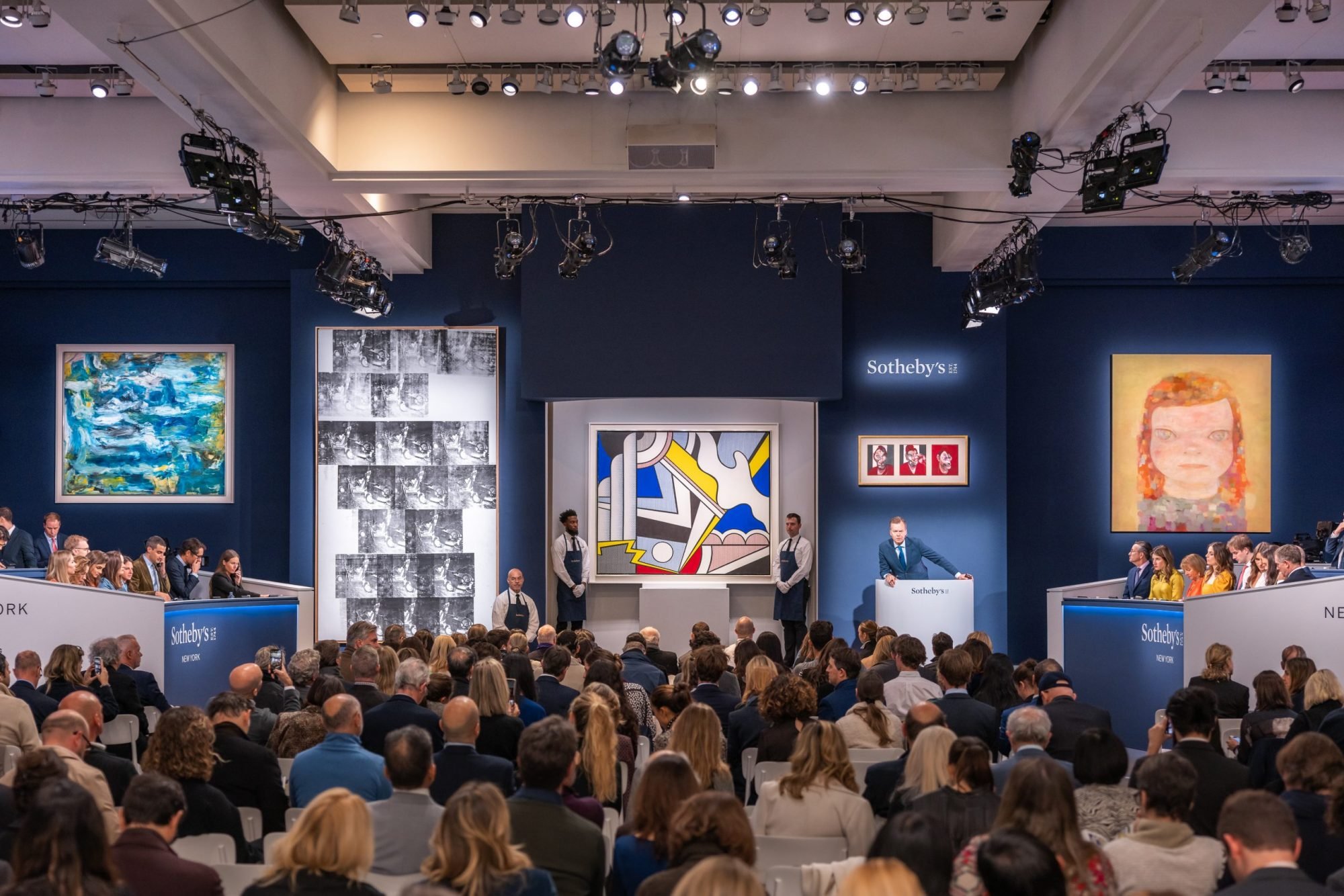
Andy Warhol’s 12-foot tall painting of a car crash fetched $84.5 million at Sotheby’s, leading the evening of postwar and contemporary art sales in New York on November 16.
It may not have been the most exciting night, but the results spoke for themselves: $314.9 million of art sold over three hours, with just two of the 60 lots unsold (and another couple of lots withdrawn). The tally was about the midpoint of the estimated range, and 65 percent higher than at equivalent auctions a year ago. Eight artists achieved personal records, including veterans Barbara Kruger ($1.25 million) and Betye Saar ($378,000). Final prices include auction-house fees; presale estimates do not.
“This is the largest auction season in history,” said Brooke Lampley, Sotheby’s chairman for global fine art. The record $1.6 billion Paul Allen collection at Christie’s set the stage. Immediately preceding it were the auctions in London, Paris, and Hong Kong and art fairs in Europe, the Middle East, and New York. “That’s a ton of art for the market to absorb. We are just happy there were only two unsold lots.”
The postwar and contemporary sale generated $269.1 million, with Warhol’s White Disaster [White Car Crash 19 Times], accounting for a third of the tally. The 1963 silkscreen carried an unpublished estimate of $80 million and hammered just below it, at $74 million. A late arrival to the November lineup, it was acquired from Thomas Ammann Fine Art AG in 1996. Some market-watchers have linked the piece to the Martinos shipping family in Greece, which is known for their Warhol holdings and close ties to Doris Ammann, who ran the Swiss gallery with her brother Thomas.
Andy Warhol, White Disaster (White Car Crash 19 Times) (1963). Courtesy of Sotheby’s.
The Warhol didn’t have an auction house guarantee in the run-up to the sale or an irrevocable bid protecting the work from going unsold. It was a risky situation, which often indicates that the seller has negotiated the hammer price and part of the auction house’s commission. But shortly before the auction, an irrevocable bid materialized, as did two bidders. The winner was a client of Grégoire Billault, Sotheby’s chairman of contemporary art, who has bid on behalf of the company’s billionaire owner Patrick Drahi. Sotheby’s declined to comment on the identities of the buyers.
The named sellers included the family of Willem de Kooning, who consigned three superb paintings by the AbEx master. All three were guaranteed by Sotheby’s and two were backed with irrevocable bids. They achieved decent prices but failed to fly.
Willem de Kooning, Untitled (c. 1979). Courtesy of Sotheby’s.
Montauk II, a 1969 oil on paper mounted on canvas, fetched $12.7 million, in the middle of the estimated $10 million to $15 million range. An untitled 1979 canvas, turbulent like a stormy sea, totaled $34.8 million, also within the estimate. The Hat Upstairs (1987), a pared-down late example by the artist, went for $10.7 million, just surpassing the $9 million low estimate.
The auction initially included three paintings by the late Joan Mitchell, who has gained renewed attention with a blockbuster exhibition duetting with Claude Monet at Fondation Louis Vuitton in Paris and a solo show at David Zwirner in New York. The most expensive of the three works, Yves, was withdrawn; it had been estimated at $10 million to $15 million.
Francis Bacon’s Three Studies for Portrait of Lucian Freud, guaranteed by Sotheby’s and backed by a third-party investor, fetched $30 million, at the low estimate, and beat out last week’s self-portrait triptych by Bacon from the estate of Paul Allen, which fetched $29 million. Sotheby’s said that the work was acquired by a prominent English collection but declined to name the buyer.
Auctioneer Oliver Barker at Sotheby’s contemporary art evening sale on November 16. Photo courtesy of Sotheby’s.
Many were watching the results for signs of the looming recession making landfall in the art market. While things were selling, there were few protracted bidding wars, with a number of works hammering at or below expectations. “Before we had these fireworks,” said Monaco-based art advisor Michaela Neumeister de Pury. “Now many works just scraped the low estimates. Still, it’s solid.”
The Now—a mini-auction focused on ultra-contemporary art before the main event—was a white-glove sale for the third consecutive time since launching in November 2021, Sotheby’s was quick to point out. Every lot sold (although one was withdrawn prior to the auction). It totaled $45.8 million, surpassing the high estimate of $42.2 million, but 42 percent down from a year ago.
Records were set for five artists including Salman Toor ($1.6 million), Jacqueline Humphries ($850,500), and Carol Bove ($787,500).
Salman Toor, Four Friends (2019). Courtesy of Sotheby’s.
Asian bidders were active, acquiring 50 percent of works by value in The Now auction. Wendy Lin, deputy chairman of Sotheby’s Asia, won Cecily Brown’s luscious Eyes Wide Shut for $4.5 million, within the estimate range, as well as Christina Quarles’s Bits n’ Pieces for $1.6 million.
Darren Entwistle, chief executive officer of tech company Telus, and his wife Fiona sold two lots. One of them was a blue stainless steel sculpture Dressing Room (2017) by Bove that went on to set a new record for the in-demand artist.
Christine Quarles, Bits n’ Pieces (2019). Courtesy of Sotheby’s.
There was a sense that the ultra-contemporary market has slowed its vertiginous ascent of the past two years. During one telling moment, auctioneer Michael Macaulay introduced Picnic on the Grounds (2017–18), a work on paper by Toyin Ojih Odutola, by reminding the audience that the artist’s auction record of $2.2 million was set at Sotheby’s just one year ago. This time around, the final price was $945,000.
“It’s not a crash, but it seems like things have slowed down,” said New York collector Max Dolgicer. “Competitive bidding was much higher last year and even in May. People, who thought that the Paul Allen sale is an indicator of where the market is, are wrong. It was an exception.”